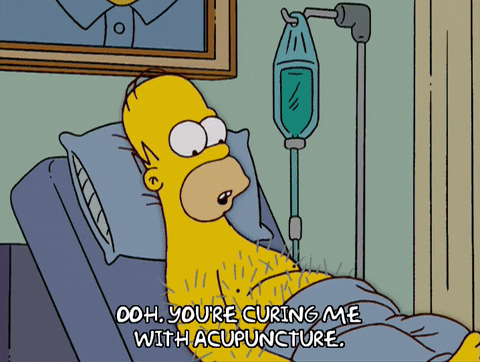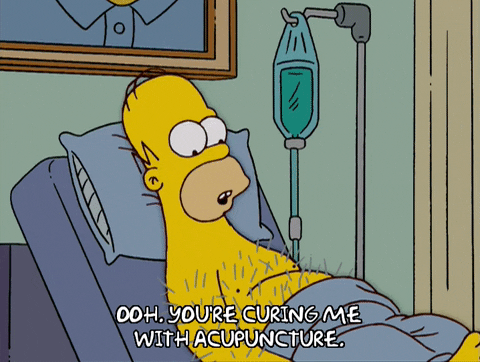Flick Technique
Let's be honest, no one really likes needles. I've never had a patient walk in my door and say they love needles...not even people covered in tattoos! Even if they say they don't mind, most folks have a healthy fear of needles. Unfortunately, to get the best benefit from acupuncture, you must have needles!
There are numerous alternatives-to-acupuncture products out there like acupressure mats, reflexology tools, pressure pointers and scalp massage's. You'll even hear about massage therapists offering "needle-free acupuncture", which, by the way, isn't a thing. It's just a marketing ploy and they are really just massaging acupuncture points (acupressure). There is also laser acupuncture which is the closest to physical acupuncture with less intensity. Lasers can stimulate targeted nerve bundles, AKA acupuncture points, and increase blood flow and hormone activity to the area however it does not cause the physical disruption of sliding through the fascia and muscle like a needle does. The mechanical stimulation that needles provide is essential. A TENs unit or electrical stimulation device creates a similar therapeutic effect to acupuncture but only stimulates nerves close to the surface of the skin. An acupuncture needle stimulates nerves deep in muscles, surrounding joints, and even nerves that wrap around organs. So while these acupuncture alternatives are helpful, real acupuncture knocks all these other therapies out of the water with little effort.
There are some therapists who spend only a weekend course learning acupuncture or dry needling. This can provide some relief for their patients but often leaves much to be desired. What it really comes down to is finding an expert who really can use the needle as their paint brush. That's where the magic happens. I've seen it all too often in the acupuncture world where an acupuncturist is so afraid of hurting someone that they fail to provide adequate stimulation for a truly successful treatment. Instead of inserting the needle quickly, forcefully, and deep enough, they close their eyes, hesitantly tap the needle in slowly, and once it is barely under the skin, don't touch it due to fear of negative patient feedback. My thoughts: That isn't therapeutic enough. You can't half *donkey* it!
Imagine throwing a football to your friend 25 feet away and once your arm reaches even with your head you let the ball go immediately. Obviously if your motion fails to follow through the ball would get about 5 feet and drop straight down. This "follow through" motion is one of the keys to my specialized pain-free insertion method called the Flying Needle technique. Force and follow through along with practice, practice, practice is what results in a much more comfortable experience. Unfortunately (or, fortunately) for the patients of mine who have seen only me for acupuncture and no other practitioners they may not have a good gauge on what "regular" acupuncture insertion feels like. After being very lucky to learn this Flying Needle technique, and going home every night and practicing for hours on my leg or a different texture of fruit, I finally mastered it. It wasn't until I went to China in 2015 to meet the 75 year old physician, Dr. Wang, famous for his family lineage in inventing the Flying Needle technique that I was actually very quickly corrected that what I do is definitely NOT true Wang-style Flying Needle. (This is a funnier story in hindsight.) After mastering this needle technique, and only knowing one other person who used it (the lady I learned it from), I wrote part of my Doctoral dissertation on the technique and its impact versus traditional needling. Then in 2015 I got the opportunity to study under Dr. Wang himself. When I arrived to his clinic, Dr. Wang asked me to show him my technique (with about 25 other people watching). We quickly found out that the style he practices and the style I practice is actually quite different! I was horrified, embarrassed, and cracking up all at the same. I traveled all the way to China to find out what I did was not true Flying Needle technique, at least not Wang-Style! So, now I can come up with my own name, which I will call it the Flick technique. Not to be confused with my last name, but truly, I do use a Flick to insert the needle.
I recently ran into an old intern of mine whom I taught this technique to years ago. I asked her how it had been going and if she was using it regularly. She responded, "no, it was too hard to learn." This seems to be the biggest reason, other than fear, that acupuncturists do not use a technique like this. I am a huge advocate of the Flick technique not just because of its pain-free insertion but because the physical differences between the Flick technique and traditional tube needling is profound. Based on the research I conducted for my dissertation our brain actually responds differently to the Flick technique and patients can absolutely feel the difference!
When you subscribe to the blog, we will send you an e-mail when there are new updates on the site so you wouldn't miss them.




Comments